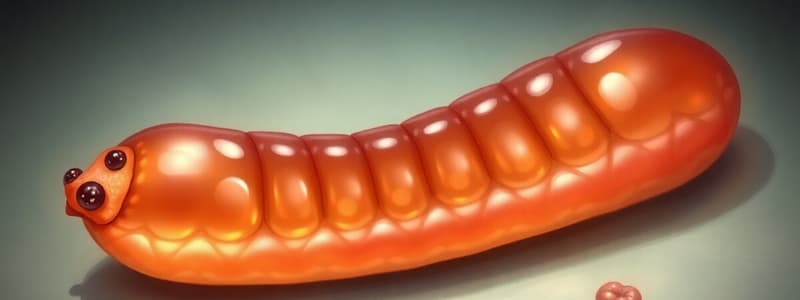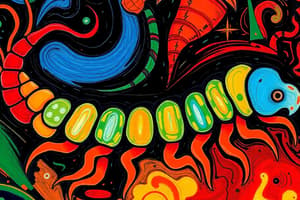Podcast
Questions and Answers
What is the primary function of the anterior and ventral suckers in Digenetic Trematodes?
What is the primary function of the anterior and ventral suckers in Digenetic Trematodes?
- Attachment (correct)
- Movement
- Reproduction
- Nutrient absorption
Which structure of Digenetic Trematodes is involved in waste collection and excretion?
Which structure of Digenetic Trematodes is involved in waste collection and excretion?
- Circum-esophageal ring
- Flame cell (correct)
- Ganglia
- Ventral sucker
Which liver fluke is commonly referred to as Fasciola hepatica?
Which liver fluke is commonly referred to as Fasciola hepatica?
- Tropical large liver fluke
- Common liver fluke (correct)
- Small liver fluke
- Bile duct fluke
What is the intermediate host of Fasciola hepatica?
What is the intermediate host of Fasciola hepatica?
Identify a key characteristic of the eggs of Fasciola hepatica.
Identify a key characteristic of the eggs of Fasciola hepatica.
What is the primary intermediate host for Fascioloides magna?
What is the primary intermediate host for Fascioloides magna?
Which characteristic is NOT true of Fasciolopsis buski?
Which characteristic is NOT true of Fasciolopsis buski?
Identify the definitive hosts for Fascioloides magna.
Identify the definitive hosts for Fascioloides magna.
What is the typical predilection site for Fasciolopsis buski?
What is the typical predilection site for Fasciolopsis buski?
Which of the following features describes Fascioloides magna?
Which of the following features describes Fascioloides magna?
Flashcards are hidden until you start studying
Study Notes
Class Trematoda: Digenea
- The outer cuticle layer of trematodes may have spines
- They have an anterior (oral sucker) and ventral sucker (acetabulum) for attachment
Excretory System
- The simplest form of the excretory system is a sac-like bladder that terminates in the posterior part of the body
- Flame cells are excretory cells collecting waste products from the surroundings
Nervous System
- The nervous system is composed of a circum-esophageal ring of fibers and ganglia
- Adults do not have sense organs, but free-living larval forms (miracidium and cercaria) may have patches of pigment called eyespots
Family Fasciolidae
- There are three important genera: Fasciola, Fascioloides, and Fasciolopsis
Genus Fasciola: Fasciola hepatica
- The common liver fluke or sheep liver fluke
- Ova are thin-shelled, oval, operculate, browny-yellow, and large
- The testes, ovary, and ceca are branched
- The predilection site is the liver and bile ducts
- Definitive hosts (DH) include sheep, cattle, goats, horses, deer, humans, and other mammals
- Intermediate hosts (IH) are snails of the genus Lymnaea, with the most common being Lymnaea truncatula
Genus Fasciola: Fasciola gigantica
- The tropical large liver fluke
- Ova are similar to F. hepatica but larger
- The predilection site is the liver and bile ducts
- IH are snails of the genus Lymnaea
- DH include cattle, buffalo, sheep, goats, pigs, camels, deer, and humans
Genus Fascioloides: Fascioloides magna
- The giant liver fluke, large American liver fluke, or deer fluke
- It is large and thick with no anterior cone, a rounded posterior end, and a flesh-colored appearance when fresh
- The predilection site is the liver and occasionally the bile duct
- DH include deer, cattle, sheep, goats, pigs, and horses
- IH include various freshwater snails such as Fossaria spp., Lymnaea spp., and Stagnicola spp.
Genus Fasciolopsis: Fasciolopsis buski
- The predilection site is the small intestine
- DH include humans and pigs
- IH are “flat shelled snails” such as Planorbis sp., Segmentina sp.
- It is a large, thick-set fluke without shoulders, elongate oval, slightly broader posteriorly, and has a ventral sucker near the anterior extremity that is much larger than the oral sucker
- The intestinal ceca are unbranched
- The testes are tandem, branched, and posterior in position
- The ovary is slightly to the right of the midline
- The vitelline glands occupy the lateral fields
Genus Parafasciolopsis: Parafasciolopsis fasciolaemorpha
- The predilection site is the gallbladder and digestive tract
- DH include elk and wild goats
- It is 3-7.5 mm long and 1-2.5 µ in diameter
- IH is the snail Coretus sp.
Illustrations
- The following illustrations must be submitted:
- Fasciola gigantica whole mount
- Fasciola gigantica longitudinal section (anterior end only)
- Fasciola hepatica
- Fascioloides magna
- Fasciolopsis buski
- Fasciola ovum
- Fasciola miracidium
- All illustrations must be traditional drawings and labeled
- The deadline for submission is September 30, 2024 (Monday)
Studying That Suits You
Use AI to generate personalized quizzes and flashcards to suit your learning preferences.



